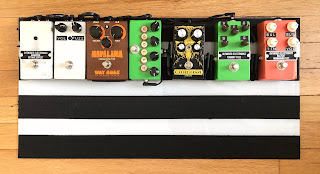I bought 2 Sescom SM-1A direct boxes for about $30 in 2013 and 2014 to record direct guitar and bass. I couldn’t find the specifications for my particular units from the 70’s/80’s. By 1990, the SM-1A was on its mkii model and had an input impedance of 60k. This is rather low for guitar DI purposes by modern conventions, but I was happy to play through it at the time with early guitar amp sims (LePou, Ignite Amps, TSE, Nick Crow, etc.). I used a Korg DT10 (1 MOhm input Z) to split/buffer my input occasionally, so I got around the low impedance issue without knowing it. I still like using the SM-1A for bass guitar and synths.
I dug these direct boxes out again and took a peek at the innards. The transformers look like they are in MuMetal cans.
 |
| Different finishes during its production run. |
 |
| The guts of one SM-1A. |
 |
| The guts of a second SM-1A. |
Edit - 8/9/24 - I pulled out my SM-1A to do some informal comparisons to my typical DI rig in 2024. I typically use a Waves/PRS Guitar Interface into my Steinberg UR824 Audio Interface when I am not using my HX Stomp or Fractal FM3. With these 3 options, my guitar or bass is loaded by a 1Mohm input impedance in all cases.
My first test was to compare how the two chains handled a buffered bass guitar signal. I used my Ibanez Mikro Bass set on the P-pickup (6.27kohm DC resistance). I split my signal using a old Korg DT10 tuner, so the takes would be identical.
One output went to the Waves/PRS Guitar Interface, while the other went to the Sescom DI into a CAPI VP28 preamp. Both chains were within 0.3dB of my usual 11.5dBu DI chain. Once the gain difference was taken care of, the two signals were very similar. The Sescom/VP28 chain is going through a total of four transformers and two 2520-style discrete op-amps, while the Waves/PRS Guitar Interface amplifies the signal with none of these mojo parts.
Ibanez Mikro Bass - Korg DT10 - Sescom SM-1A - CAPI VP28 - Steinberg UR824 Line In
Ibanez Mikro Bass - Korg DT10 - Waves/PRS Guitar Interface - Steinberg UR824 Line In
I then tried the bass directly into each input chain. I had to record separate takes, making it a very flawed comparison. I did recorded multiple passes because I didn't trust my playing to be consistent. Several key differences kept showing up:
- The signal through the Sescom/VP28 was suddenly 1.7dB louder than through the Waves DI.
- Even with this gain difference balanced out, there was a frequency response difference. The Sescom chain captured more harmonics differently in the 1-2k range.
- The direct sound of the bass into the Waves DIs were comparable in level and sound to the buffered examples.
- The direct sound of the bass into the Sescom chain consistently had more mid-range.
Ibanez Mikro Bass - Sescom SM-1A - CAPI VP28 - Steinberg UR824 Line In
Ibanez Mikro Bass - Waves/PRS Guitar Interface - Steinberg UR824 Line In
Ibanez Mikro Bass - Sescom SM-1A - CAPI VP28 - Steinberg UR824 Line In - 1.7dB trim in DAW
 |
| Sescom (-1.7dB) and Waves/PRS different takes compared. |
These observed differences are likely due to the impedance loading presented by the Sescom transformer. The buffered output of the Korg DT10 had likely converted the signal to low impedance, for which both chains interfaced in a similar manner.
The direct bass into the Sescom DI demonstrated weaker impedance matching (6k to 60k), which likely contributed to the change in frequency response. This coloration is probably welcome on bass, but probably detrimental for electric guitar DIs to be processed by amp modeling.






